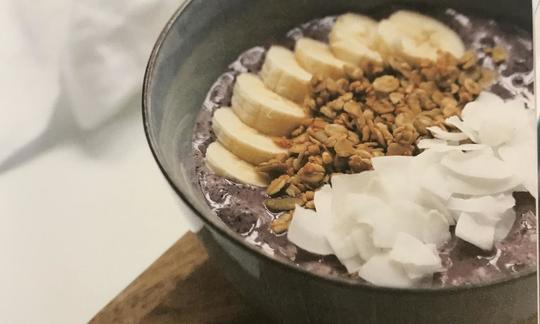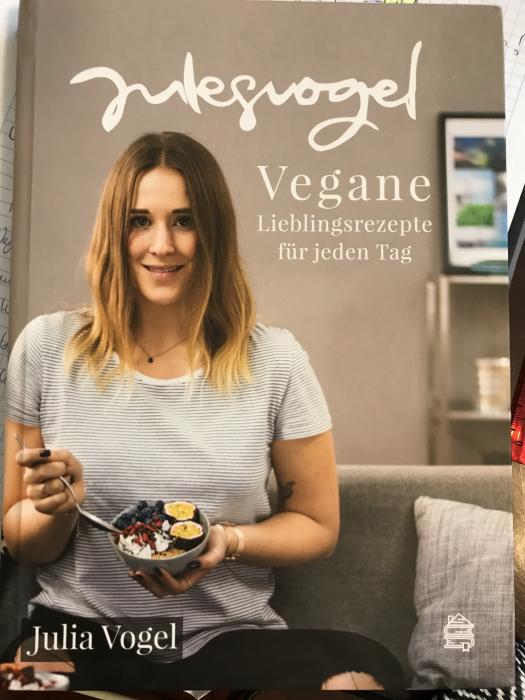Blueberry Smoothie Bowl with Bananas and Coconut Flakes
raw-vegan
Ingredients (for serving, )
| To freeze | |
|---|---|
| 1 | Bananas, raw (organic?) (4.1 oz) |
| Prepare fresh | |
| 3 ½ oz | Blueberries (blueberries), raw (organic?) |
| 1 | Bananas, raw (organic?) (4.1 oz) |
| 2 tbsp | Coconut chips (coconut chips, raw?, organic?) (0.56 oz) |
| ½ | Vanilla pod (also Bourbon vanilla, organic?) (0.05 oz) |
| 50 ml | Almond milk (raw?, organic?) (1.7 oz) |
Equipment
- blender or hand-held blender / immersion blender
- freezer
Type of preparation
- chop or grind
- food preparation without heating
- blend
- put on ice
Preparation
Preparation - freezing
For each serving, slice one banana and place in the freezer.Leave the banana in the freezer for at least 40 minutes. You can also do this in advance and freeze more than one banana at a time so that you have them ready whenever you need them.
For the smoothie
Blend the blueberries, frozen and fresh banana, almond milk, and vanilla.You can use any type of plant-based milk. If you don’t have fresh blueberries, frozen ones will also work.
Depending on the quality of your blender, you might want to wait a bit and let the frozen ingredients thaw a bit before blending. This will give the drink a smoother consistency.
Serving
Serve the smoothie with fresh fruit, coconut chips, and granola (optional).A recipe for granola can be found on page 40 of the same cookbook.
We recommend adding 15 g chopped walnuts.
|
Nutritional Information per person
Convert per 100g
|
2000 kcal | |
|---|---|---|
| Energy | 392 kcal | 19.6% |
| Fat/Lipids | 13 g | 18.4% |
| Saturated Fats | 11 g | 53.4% |
| Carbohydrates (inc.dietary fiber) | 74 g | 27.3% |
| Sugars | 41 g | 45.3% |
| Fiber | 11 g | 45.7% |
| Protein/Albumin | 4.8 g | 9.6% |
| Cooking Salt (Na:33.1 mg) | 84 mg | 3.5% |
| Essential micronutrients with the highest proportions | per person | 2000 kcal | |
|---|---|---|---|
| Min | Manganese, Mn | 1.4 mg | 70.0% |
| Vit | Vitamin B6 (pyridoxine) | 0.94 mg | 67.0% |
| Elem | Potassium, K | 1'090 mg | 55.0% |
| Min | Copper, Cu | 0.38 mg | 38.0% |
| Vit | Vitamin C (ascorbic acid) | 30 mg | 38.0% |
| Vit | Vitamin B7 (Biotin, ex vitamin H) | 15 µg | 29.0% |
| Vit | Vitamin B9, B11 (Folate, as the active form of folic acid) | 55 µg | 28.0% |
| Vit | Vitamin K | 20 µg | 27.0% |
| Elem | Magnesium, Mg | 92 mg | 25.0% |
| Elem | Phosphorus, P | 150 mg | 21.0% |
Detailed Nutritional Information per Person for this Recipe
The majority of the nutritional information comes from the USDA (US Department of Agriculture). This means that the information for natural products is often incomplete or only given within broader categories, whereas in most cases products made from these have more complete information displayed.
If we take flaxseed, for example, the important essential amino acid ALA (omega-3) is only included in an overarching category whereas for flaxseed oil ALA is listed specifically. In time, we will be able to change this, but it will require a lot of work. An “i” appears behind ingredients that have been adjusted and an explanation appears when you hover over this symbol.
For Erb Muesli, the original calculations resulted in 48 % of the daily requirement of ALA — but with the correction, we see that the muesli actually covers >100 % of the necessary recommendation for the omega-3 fatty acid ALA. Our goal is to eventually be able to compare the nutritional value of our recipes with those that are used in conventional western lifestyles.
| Essential fatty acids | per person | 2000 kcal |
|---|---|---|
| Alpha-Linolenic acid; ALA; 18:3 omega-3 | 0.12 g | 6.0% |
| Linoleic acid; LA; 18:2 omega-6 | 0.44 g | 4.0% |
| Essential amino acids | per person | 2000 kcal |
|---|---|---|
| Tryptophan (Trp, W) | 0.03 g | 14.0% |
| Threonine (Thr, T, irreversibly transaminated) | 0.13 g | 14.0% |
| Phenylalanine (Phe, F) | 0.21 g | 14.0% |
| Valin (Val, V) | 0.22 g | 14.0% |
| Leucine (Leu, L) | 0.30 g | 12.0% |
| Isoleucine (Ile, I) | 0.14 g | 11.0% |
| Lysine (Lys, K, irreversibly transaminated) | 0.20 g | 11.0% |
| Methionine (Met, M) | 0.05 g | 6.0% |
| Vitamins | per person | 2000 kcal |
|---|---|---|
| Vitamin B6 (pyridoxine) | 0.94 mg | 67.0% |
| Vitamin C (ascorbic acid) | 30 mg | 38.0% |
| Vitamin B7 (Biotin, ex vitamin H) | 15 µg | 29.0% |
| Vitamin B9, B11 (Folate, as the active form of folic acid) | 55 µg | 28.0% |
| Vitamin K | 20 µg | 27.0% |
| Vitamin B2 (Riboflavin) | 0.28 mg | 20.0% |
| Vitamin B3 (Niacin) | 2.4 mg | 15.0% |
| Vitamin B5 (Pantothenic acid) | 0.91 mg | 15.0% |
| Vitamin E, as a-TEs | 1.7 mg | 14.0% |
| Vitamin B1 (Thiamine) | 0.11 mg | 10.0% |
| Vitamin A, as RAE | 25 µg | 3.0% |
| Essential macroelements (macronutrients) | per person | 2000 kcal |
|---|---|---|
| Potassium, K | 1'090 mg | 55.0% |
| Magnesium, Mg | 92 mg | 25.0% |
| Phosphorus, P | 150 mg | 21.0% |
| Calcium, Ca | 104 mg | 13.0% |
| Sodium, Na | 33 mg | 4.0% |
| Essential trace elements (micronutrients) | per person | 2000 kcal |
|---|---|---|
| Manganese, Mn | 1.4 mg | 70.0% |
| Copper, Cu | 0.38 mg | 38.0% |
| Iron, Fe | 2.0 mg | 14.0% |
| Zinc, Zn | 0.83 mg | 8.0% |
| Iod, I (Jod, J) | 9.0 µg | 6.0% |
| Selenium, Se | 2.5 µg | 4.0% |
| Fluorine, F | 5.9 µg | < 0.1% |
Vegan Favorite Recipes for Every Day by Julia Vogel contains simple, quick recipes for vegans and all those who are just looking for variety.
Since this book is written in German, a description is omitted here. If you are interested, please switch to German in the menu.
This Blueberry Smoothie Bowl with Bananas and Coconut Flakes has a sweet, fruity flavor — without any added sugar. It also tastes great served with granola.
Nutritional profile: This smoothie is rich in manganese and vitamin B6. We recommend adding chopped walnuts (see “Alternative Preparation”) in order to optimize the ratio of omega-6 to omega-3 fatty acids.
Wild and cultivated blueberries: Scientific studies show that blueberries have one of the highest antioxidant levels of all fruits. The Oxygen Radical Absorbance Capacity (ORAC) comes in at about 4669 µmol trolox equivalents (TE) per 100 gram sample (USDA). This value is a measure of a food’s ability to neutralize free radicals. The higher the value, the more antioxidants the food contains. Other berries with similarly high levels of antioxidants include lignonberries, black currants, and aronia berries.
Bananas: Bananas have a very balanced combination of carbohydrates. When it comes to the trace elements, bananas contain the most copper of all fruits and vegetables. They also contain more iron than most fruits and are rich in potassium, phosphorus, and magnesium. Of all the fruits, bananas have the highest levels of manganese. Manganese is particularly important for the metabolism of carbohydrates. In addition, vitamin B1 in the tissues can only be used if manganese is present as it is necessary for certain enzymatic functions in the metabolism of B1.
Almond milk: Almond milk is a plant-based milk containing almonds and water that is used as an alternative to dairy milk. You can use commercial almond milk or make it yourself. See the link under “Alternative preparation.” You can customize homemade almond milk and make it thicker or thinner to suit your taste preferences. Store-bought almond milk usually contains less than 10 % almonds. Almonds (like parsley) are a good source of iron.
The author’s tip on bananas: Be sure to use bananas that are as ripe as possible — this way, your smoothie bowls will taste much sweeter and creamier.
Wash the blueberries well: Even blueberries you’ve picked yourself should be washed well before eating raw. If you have any reason to be concerned, you should also cook them before eating. This is important because, depending on the area, the danger of fox tapeworm (Echinococcus multilocularis) infections cannot be ruled out.
Plant-based milk: Instead of the almond milk, you can also use any other plant-based milk you like.
Make your own almond milk: You can find a recipe for homemade almond milk under the following link:
Raw Almond Milk.
Walnuts: We recommend adding 15 g chopped walnuts. This shifts the ratio of omega-6 to omega-3 fatty acids from 10:1 to 5:1, which corresponds to the recommended maximum ratio.




